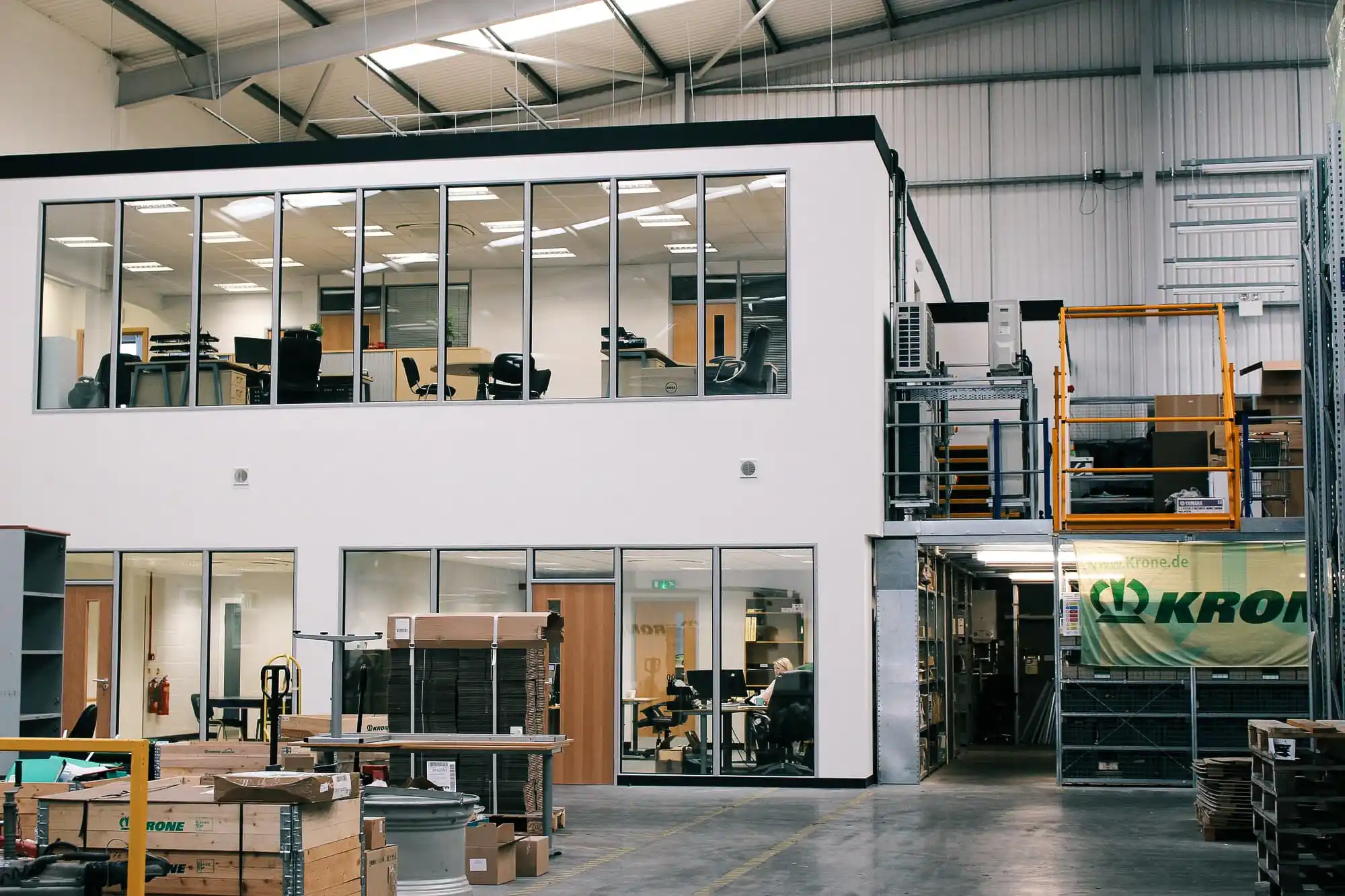Are you thinking about adding a mezzanine office to your business to gain valuable square footage? That’s a smart move! Mezzanines are a fantastic way to create extra room without the hassle of a full-blown building expansion. But before you start picking out paint colors and ordering furniture, you need to be aware of the building regulations that apply.
This comprehensive guide will walk you through everything you need to know about navigating building regulations for mezzanine construction. We’ll cover important considerations like load-bearing capacity, egress requirements, fire safety, and accessibility, ensuring your mezzanine office is both functional and compliant.
Building Regulations Application for a Mezzanine Office
Just like any construction project, building a mezzanine isn’t a free-for-all. You need to get the green light from your local building department before you start. This ensures your mezzanine plans meet safety and building codes and won’t compromise the structural integrity of your building.
Getting the Green Light: Building Regulation Approval
Think of the building regulation approval process like submitting blueprints for a new addition to your home. Your local building authority needs to review and approve your mezzanine plans to ensure they meet code requirements. They will typically want to see the following:
- Detailed floor plans: Clearly illustrate the location, dimensions, and layout of the mezzanine within the existing space.
- Property plans with clearly marked fire exits: Demonstrate how occupants will safely evacuate the building in case of an emergency.
- A concise description of the proposed work: Provide a clear overview of the construction methods and materials to be used.
This review process can take several weeks, so factor that into your project timeline. It’s crucial to be patient and work closely with your local building department to avoid costly rework or potential fines.
Mezzanine Levels: What’s the Deal?
Picture a stylish, elevated platform nestled within your existing office space, creating an entirely new level – that’s your mezzanine! It’s essentially a bonus floor, cleverly tucked within your building’s structure without requiring a full-blown addition. Mezzanines are incredibly versatile, providing additional office space, meeting rooms, break areas, or storage.
What sets mezzanines apart from a full second floor is that they usually don’t span the entire floor area. They’re designed with a lower ceiling height than your main floor, offering an open view of the space below. This design element not only enhances natural light flow but also contributes to a more spacious and airy feel.
The IBC: Your Mezzanine’s Rulebook
Building regulations are in place to keep everyone safe. The International Building Code (IBC) is the gold standard for construction, and Section 505.2 specifically addresses mezzanine construction. Let’s explore some key points:
- Emergency Exits (Egress): Safe and accessible escape routes are non-negotiable in any building project, especially when adding a mezzanine level. The IBC outlines specific requirements for the number, location, and width of exits to ensure occupants can evacuate quickly and safely during an emergency.
- Openness is Key: Mezzanines cannot be completely closed off boxes. Adequate ventilation and openness are crucial to prevent the trapping of smoke and heat in case of a fire. This ensures the safety of occupants on both the mezzanine and the main floor.
- Floor Area Limits: You can’t just build a massive mezzanine that overshadows your main floor. The IBC sets limits on the maximum floor area a mezzanine can occupy. This ensures the structural stability of both the mezzanine and the existing building, preventing overloading and potential collapse.
Designing Your Dream Mezzanine Office
With building regulations covered, let’s move on to the fun part – designing your dream mezzanine office! Here are essential factors to consider:
- Floor Type: Durability and style go hand in hand! Choose a flooring material that can withstand the demands of an office environment while complementing your desired aesthetic. Consider factors like foot traffic, noise reduction, and ease of cleaning.
- Ceiling Height: Nobody wants to feel cramped in their workspace! Ensure your mezzanine’s ceiling height meets those all-important building code requirements (typically a minimum of 7 feet) while providing a comfortable and spacious feel.
- Let There Be Light!: Proper lighting is crucial for productivity and creating a positive work environment. Maximize natural light by incorporating windows or skylights. Supplement with energy-efficient artificial lighting to ensure adequate illumination throughout the space.
- Breathe Easy with Proper Ventilation: A stuffy office is a recipe for disaster. Ensure your mezzanine has a well-designed ventilation system that keeps the air fresh, circulates clean air, and prevents stuffiness.
Building a mezzanine office is an exciting project, and by following building regulations and thoughtfully considering your design choices, you’ll create a fantastic space that’s both functional, compliant, and aesthetically pleasing. Remember to work closely with your local building authority – they’re there to help you navigate the process and ensure a successful outcome.
Understanding Load-Bearing Capacity and Egress Requirements for Mezzanine Offices
Ensuring the structural integrity of your mezzanine and providing safe exit routes in case of an emergency are two paramount considerations.
Making Sure Your Mezzanine Can Handle the Weight: Load-Bearing Capacity
Imagine a bridge carrying the weight of cars and trucks – it needs robust supports to handle the load. The same principle applies to your mezzanine. Load-bearing capacity refers to the maximum weight a structure can safely support. This includes the weight of the mezzanine itself (its materials, beams, columns, flooring, etc.), as well as live loads, which encompass everything that will occupy the space, such as:
- Desks, chairs, and other office furniture
- People (occupants, visitors)
- Equipment (computers, printers, etc.)
- Stored items
Failing to accurately calculate and account for these loads can lead to structural issues like sagging, buckling, or even collapse. That’s why consulting a qualified structural engineer is crucial.
The Role of a Structural Engineer
Structural engineers are the superheroes of the construction world. They possess the expertise to analyze your existing building structure, evaluate your mezzanine plans, and determine the necessary support systems to handle the anticipated loads. They’ll consider factors like:
- The strength and condition of your existing building: Are the foundations, walls, and columns strong enough to support the additional weight?
- The size and layout of your mezzanine: How much weight will be distributed across the structure?
- The materials you plan to use: Different materials have varying load-bearing capacities.
Based on their calculations, they’ll recommend appropriate beam sizes, column placements, and connection details to ensure your mezzanine can handle the weight without compromising safety.
Getting Everyone Out Safely: Egress Requirements
Imagine a fire alarm blaring in your building. You need to ensure everyone on your mezzanine can evacuate quickly and safely. That’s where egress requirements come in.
Egress simply means “exit.” Egress requirements dictate the following:
- Number of exits: Your mezzanine will likely need at least two exits, strategically located to provide alternative escape routes.
- Location of exits: Exits should be clearly marked and easily accessible from all areas of the mezzanine.
- Width of exits: Doors and stairwells must be wide enough to accommodate the safe evacuation of occupants, especially during an emergency.
- Travel distance: Building codes specify the maximum distance occupants can travel to reach an exit.
Key Considerations for Egress:
- Stairs or ramps: Determine the most suitable means of egress based on the mezzanine’s height and available space. Ensure stairs have appropriate tread depths, riser heights, and handrails.
- Floor surface: Choose non-slip flooring materials to prevent slips and falls during an evacuation.
- Ceiling height: Maintain adequate headroom along egress routes to prevent injuries.
- Emergency lighting: Ensure exits and pathways are well-lit, even during a power outage.
By prioritizing egress requirements, you’re creating a safe environment for everyone who uses your mezzanine.
Playing by the Rules: Building Codes
Think of building codes as the rulebook for construction. They’re established to protect public health, safety, and welfare by setting minimum standards for building design, construction, and occupancy. When it comes to mezzanines, building codes address critical aspects such as:
- Maximum allowable area: The IBC typically restricts mezzanine size to less than one-third of the floor area it occupies. This prevents overcrowding and ensures adequate egress.
- Minimum ceiling height: The IBC mandates a minimum clear height of 7 feet above and below the mezzanine to provide ample headroom and prevent injuries.
- Fire-resistant materials: Building codes often require the use of fire-resistant materials, such as one-hour rated tiles and light fixtures, to slow the spread of fire and protect occupants.
Remember: Building codes can vary depending on your location. Always consult with your local building department to determine the specific requirements in your area.
Do You Need Planning Permission for a Mezzanine Office?
While you might not always need full-blown planning permission for a mezzanine office, securing building regulation approval is non-negotiable. These regulations exist to ensure your mezzanine is safe, structurally sound, and compliant with fire and accessibility standards.
When You Might Need Planning Permission:
- Listed buildings: If your building is listed or located within a conservation area, you’ll likely need planning permission for any alterations, including a mezzanine.
- Significant alterations: Large mezzanines that significantly alter the appearance or structure of your building might require planning permission.
- Change of use: If adding a mezzanine changes the intended use of the building (e.g., from storage to office space), planning permission might be necessary.
Always check with your local planning authority to determine if your mezzanine project requires planning permission.
Building Regulations: Your Mezzanine’s Best Friend
Don’t let the term “regulations” intimidate you. Think of building regulations as your guide to creating a safe and compliant mezzanine office. Here’s a closer look at what they cover:
Fire Safety is Paramount
Fire safety is crucial in any building, especially when adding a mezzanine level. Building regulations address fire safety in several ways:
- Fire-resistant construction: Using fire-resistant materials helps contain fires and slow their spread, giving occupants valuable time to evacuate.
- Fire suppression systems: Depending on the size and use of your mezzanine, you might need to install a sprinkler system to automatically extinguish fires.
- Fire alarms and detection: Building regulations mandate the installation of fire alarms and detection systems to provide early warning in case of a fire.
Accessibility for Everyone
A well-designed mezzanine should be accessible to everyone, including people with disabilities. Building regulations ensure your mezzanine is inclusive by addressing:
- Accessible entrances and exits: Providing ramps or lifts in addition to stairs ensures everyone can access the mezzanine.
- Accessible restrooms: If your mezzanine includes restrooms, they must be designed to accommodate wheelchair users.
- Clearance and maneuvering space: Hallways, doorways, and workspaces should provide adequate clearance for wheelchair users to navigate comfortably.
Other Important Considerations
Building regulations cover several other crucial aspects of mezzanine construction, including:
- Structural integrity: Ensuring the mezzanine can safely support the intended loads.
- Sound insulation: Minimizing noise transfer between the mezzanine and other areas of the building.
- Ventilation and air quality: Providing adequate ventilation to ensure a comfortable and healthy work environment.
By adhering to building regulations, you’re creating a mezzanine office that’s not only aesthetically pleasing but also safe, functional, and inclusive for everyone.
Supersizing Your Mezzanine? Time for Extra Precautions!
If you’re dreaming of a larger mezzanine (over 400 square meters or covering more than half the room), be prepared for more stringent fire safety requirements, such as:
- Fire-rated walls: Dividing larger mezzanines into compartments using fire-rated walls helps contain fires and prevent them from spreading rapidly.
- Sprinklers: Sprinkler systems become even more critical in larger spaces to provide rapid fire suppression.
- Fire-resistant ceilings: Fire-rated ceilings help contain flames and prevent the spread of fire to upper floors.
Office or Storage? Your Mezzanine’s Purpose Matters!
Believe it or not, how you plan to use your mezzanine influences the specific regulations that apply.
- Office Space: For mezzanine offices, prioritize:
- Natural light: Ensure adequate natural light through windows or skylights to create a bright and welcoming workspace.
- Accessibility features: Incorporate accessibility features like ramps, lifts, and accessible restrooms.
- Noise control: Consider sound-absorbing materials to minimize noise distractions in the workspace.
- Storage Central: If you’re envisioning rows of neatly organized storage shelves:
- Fire safety: Prioritize fire safety measures like sprinkler systems, fire-rated walls, and adequate aisle widths for fire truck access.
- Load capacity: Ensure the mezzanine can handle the weight of stored items.
- Accessibility: Provide clear pathways and appropriate lighting for safe access to stored goods.
The Bottom Line: Play it Safe and Follow the Rules
Building a mezzanine office is a fantastic way to maximize your space and enhance your business operations. By understanding and adhering to building regulations and seeking guidance from qualified professionals like structural engineers and your local building department, you can create a stylish, functional, and above all, safe workspace that meets the needs of your business for years to come.
Remember: This guide provides general information about building regulations for mezzanine offices. Regulations can vary depending on your location and specific project details. Always consult with your local building department and qualified professionals to ensure compliance.
Want to Dive Deeper?
For more detailed information on building regulations and mezzanine floors, check out the official source: Building Regulations for Mezzanine Floors.
Explore Related Resources:
- Guide to Building a Shop Mezzanine Floor: Discover best practices for constructing a shop mezzanine that optimizes space and functionality.
- How to Treat Open Mezzanine Floor in Energy Modeling: Explore strategies for incorporating open mezzanine floors into energy modeling for sustainable design.
- Building Construction Company Profile: Learn more about our expertise and experience in building construction.
- Company Profile for Construction Site: Discover our capabilities and services for construction site management and development.
- Grass Forever in Livermore: Your Guide to Artificial Turf - April 22, 2025
- German Roaches vs. American Roaches: Key Differences and Control - April 22, 2025
- 150+ Flowers That Start With S: A Comprehensive Guide - April 22, 2025










